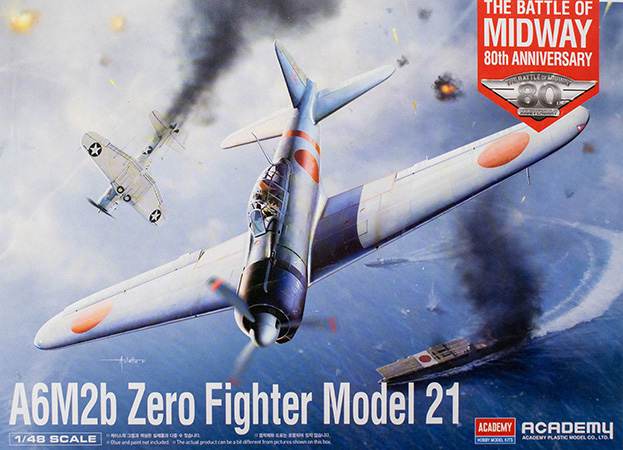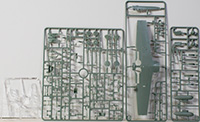
Academy 1/48 A6M2 Zero Fighter Model 21 Kit First Look
By Michael Benolkin
| Date of Review | February 2023 | Manufacturer | Academy |
|---|---|---|---|
| Subject | A6M2 Zero Fighter Model 21 | Scale | 1/48 |
| Kit Number | 12352 | Primary Media | Styrene |
| Pros | Nice details and options | Cons | See text |
| Skill Level | Experienced | MSRP (USD) | $68.95 |
First Look
 |
 |
 |
In 1937, the Mitsubishi A5M made history as the first monoplane carrier-based fighter. Codenamed Claude, the aircraft was an advanced combat aircraft that flew many combat missions during the Sino-Japanese war. Even as the A5M was entering service, military planners were looking for an even more ambitious combat aircraft that featured firepower, maneuverability, range, and carrier-capable. Two companies were given the requirements, Mitsubishi responded with the A6M. The A6M retained the duralumin construction of the A5M, but added a fully enclosed cockpit, more powerful engine, radio and navigation avionics, wide-stance retractable landing gear, and provisions for external stores. In order to achieve the proper combination of range, maneuverability, and limited take-off/landing roll, the aircraft was kept as light as possible. This meant that armor plate was not a design feature. The aircraft was named Type Zero for the year of its introduction, the Japanese year 2600 (1940) and given the codename Zeke. When allied fighter pilots first encountered the Zero in combat, they had little experience in dissimilar aerial combat training. It was through this early painful learning curve that many aircraft in-service with allied forces were suddenly looked down upon since they couldn't turn with the Zero. Nothing could turn with a Zero! It would be later that allied pilots would learn the limitations of the Zero and employ tactics that played to the strengths of their own aircraft. High-speed passes, diving passes, and the Thatch Weave were some of the tactics used to remove the Zero from the sky.
To underscore the impressive performance of the Zero, there was an airshow at Chino airport where the last remaining airworthy Sakae-powered Zero still flies. The Planes of Fame crew put the Zero and a P-51 Mustang at the end of the runway for a simultaneous take-off. As both applied full-power and released their brakes, the Zero's tail was in the air and by the time the Mustang's tail came off the runway, the Zero was airborne. By the time the Mustang got off the ground, the Zero was already climbing through 1,000 feet and accelerating away. It was a perfect mirror of those early test flights of the YF-16 taking off simultaneously with an F-4E chase aircraft. The Viper leapt into the air, went vertical, and as it passed through 5,000 feet, the F-4E chase plane was visible in the aft-facing camera still accelerating down the runway. That is light-weight performance in both cases!
Academy has taken on the Zero in kit form and has applied the latest engineering standards to the effort. What might have been a two-to-three tree kit a few years ago is now a five tree kit that offers some impressive details without over-engineering. Starting in the cockpit, the multi-part seat and seat-height adjustment system is quite impressive. Individual decals represent each of the instrument faces rather than one big decal covering the entire panel. This allows for the inclusion of a variety of fixtures and details to be included on the instrument panel and side consoles.
The kit is molded in gray styrene and presented on five parts trees plus one tree of clear parts. The kit offers the following features and options:
- Nicely detailed pilot's seat
- Optional seated pilot figure included
- Detailed cockpit with instrument panel and side console details
- Canopy can be positioned open or closed
- Masks are included for the canopies and wheels
- Nicely detailed engine and propeller
- Cowl flaps can be positioned open or closed
- Detailed main landing gear and tailwheel
- Main landing gear can be posed extended or retracted
- Main wheels are weighted
- Landing flaps can be posed open or closed
- Wing tips can be posed extened or folded
Markings are provided for five aircraft:
- A6M2, AI-102, Carrier Akagi
- A6M2, AI-152, Carrier Akagi
- A6M2, AII-168, Carrier Kaga
- A6M2, BI-151, Carrier Soryu
- A6M2, BII-124, Carrier Hiryu
This is a beautiful new tooled kit of this aircraft and should assemble with no issues. With the variety of subjects provided, you shouldn't have a problem creating a distinctive early war subject
My sincere thanks to MRC for this review sample!







